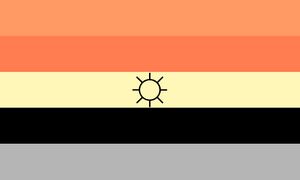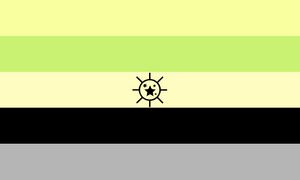Galactian system: Difference between revisions
imported>Kaiforest (source for alignment description) |
imported>BunBunPirate |
||
| Line 12: | Line 12: | ||
== Solarian == | == Solarian == | ||
The solarian identity is used to express a | The solarian identity is used to express a similarity with masculine genders, alignments, or experiences. It's a replacement for "masculine-aligned". The name of this identity comes from the fact that in many cultures, the sun is associated with masculinity and male energy.<ref name="stellunarian">[https://stellunarian.tumblr.com/post/158086623900/whats-lunarian-stellarian-and-solarian What's lunarian, stellarian and solarian? - Stellarian (tumblr)]</ref> | ||
== Lunarian == | == Lunarian == | ||
The lunarian identity is used to express a | The lunarian identity is used to express a similarity with feminine genders, alignments, or experiences. It's a replacement for "feminine-aligned". The reason is that, in many cultures, the moon is associated with femininity.<ref name="stellunarian"/> | ||
== Stellarian == | == Stellarian == | ||
Revision as of 03:20, 1 February 2019
| |
This page is about a gender identity that is not widely used among gender-variant people. This does not mean that the identity is not valid, but that very few people are known to use this term. More information on uncommon identities... |
 Meaning Chart showing the relations between the different galactian identities. There is not a single flag for all alignments. | |
| Click here to see alternative flags! |
The Galactian system is an alternative classification system for nonbinary people based on the alignment in relation to the binary genders. However, instead of male-aligned and female-aligned, it uses concepts that are not related to the binarist system, such as the sun, the moon and the stars. It's worth noting that these words were not coined to describe genders, but a relation towards a binary gender - an alignment. For instance, an agender person may identify as lunarian because they have experiences in common with women, despite not being a woman themself.[1] In the 2018 Gender Census, 0.658% of respondents identified with a galactian alignment.[2]
Galactian alignments are often used together with other gender identities, such as "solarian bigender" or "lunarian demigender".
Solarian
The solarian identity is used to express a similarity with masculine genders, alignments, or experiences. It's a replacement for "masculine-aligned". The name of this identity comes from the fact that in many cultures, the sun is associated with masculinity and male energy.[3]
Lunarian
The lunarian identity is used to express a similarity with feminine genders, alignments, or experiences. It's a replacement for "feminine-aligned". The reason is that, in many cultures, the moon is associated with femininity.[3]
Stellarian
The stellarian identity is used to express the rejection of a person towards the gender binary. It's used to express a nonbinary alignment, in contrast to feminine and masculine alignments. The reason for choosing the stars for this term is that there is a large number of different nonbinary identities and presentations, in the same way that there are many stars.[3]
Mixed alignments
A person can identify with more than one galactian identity, at the same time or in different situations. When this happens, they are can be called eclipsian (solarian and lunarian, also known as sollunarian), nebularian (lunarian and stellarian, also known as stellunarian), novarian (stellarian and solarian, also known as solstellarian) or galaxian (solarian, lunarian and stellarian, also known as solstellunarian).
Other alignments
There is another galactian identity, called singularian, which rejects any kind of relation with the gender binary, and therefore the alignment system itself. This is in contrast to stellarian, which aligns with neither male nor female within the system. Perhaps the greatest difference between the terms is that a singularian person rejects alignment entirely, and so will never identify as lunarian or solarian, while a stellarian person may identify as lunarian or solarian at different times or in different ways.[4]
Additionally, the prefix demi can be added to any of the galactian identities in order to express a partial identification with one of these identities (e.g. demisolarian, demilunarian, demisingularian...). Demi- alignments also receive proper names:
- Demisolarian: dawnian
- Demilunarian: duskian
- Demistellarian: celestian
Mixed alignments also have demi versions:
- Demi-sollunarian: twilightian
- Demi-stellunarian: equinoxian
- Demi-solstelarian: solstian
- Demi-solstellunarian: constellian.
Finally, auroran is a fluid identity between various alignments.[5]
Pride flags
This is the gallery of pride flags for the galactian identities. Click on the flags to enlarge:
Meaning
All flags follow this meaning pattern:
- The top two stripes show the varying levels in which people can experience each alignment.
- Yellow represents the nonbinary nature of those who experience that alignment.
- Black represents everyone that has no gender.
- Grey represents the varying degrees in which people can experience gender.
The colours of each flag are inspired by the natural colours of the celestial bodies or natural phenomena they represent.[5]
















